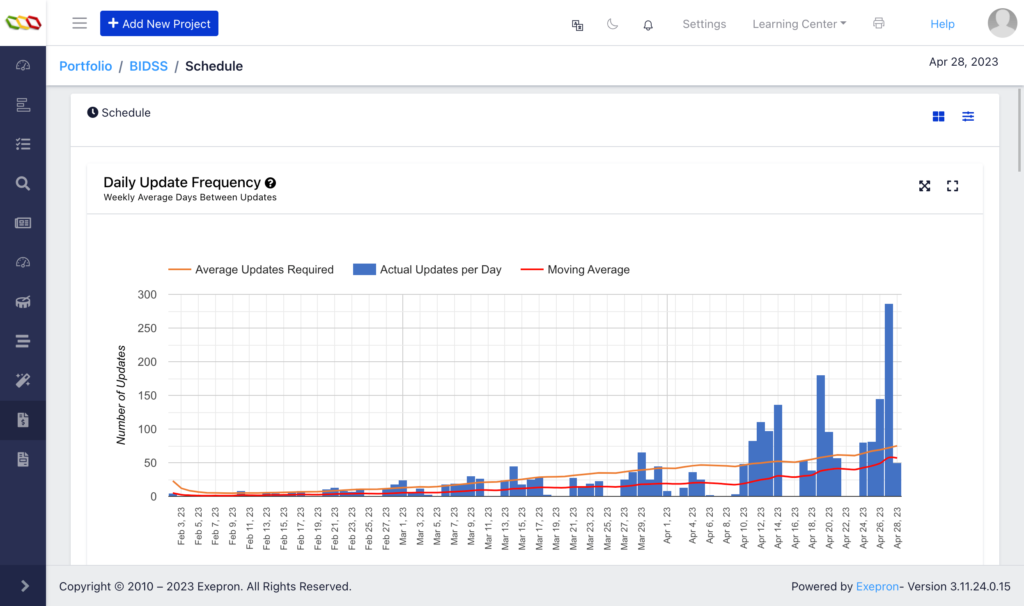The CCPM method requires a practical estimate of the REMAINING TASK DURATION, not the Percentage of a Task Duration completed.
(Managing the past performance is not impossible, but changing the future trajectory is).
Only once a Project has “Started” can the Task Remaining Duration be updated.
Execution Best Practices: Daily Updates, Weekly Meetings, Team Wide Participation. #
Daily Updating: High Frequency of Task updating to ensure Timely Decisions based on Real-Time Intelligence. [Holding a brief Daily Huddle is a best practice].
Tasks are updated according to the REMAINING TASK DURATION, not the percentage of days completed.
Remaining Task duration means Estimating the remaining duration to complete the task considering any gains or delays in time.
Example:
The planned Task Duration is five days, but we discovered a delay on day four, adding another four days before completion. This means the net remaining days are still five days remaining duration, and this will cause four days of penetration into a buffer.
Task Activities should be checked off as they are accomplished.
Checking off activities will assist in estimating the remaining Task Duration.
Best Practice Success
There is a very strong correlation between successfully delivering a portfolio of projects and the following three criteria:
- No Less than two (2) days between Task updates,
- A broad and deep span of company participation, especially by operational / Technical Resources.
- Extensive use of Notes and Reason Codes indicating thought behind the updates.
The three top reasons for poor project execution are:
- Multi-Tasking: the resource capacity time wasted cycle of Task setup, stop, setdown, setup new Task, stop, setdown, Task Setup –>Task Updating
- Starting critical Tasks without having a “Full Kit” of required elements: Material, Instructions, Approvals, Equipment, etc.Dynamic Drum Scheduling (Staggering a Pipeline of Projects and evaluate Resource Loading). Full Kitting: Modeling and Milestones full Kitting in Exepron.
- Starting too many Projects and or too many Tasks at once. Use of Expron’s Dynamic Drum is desinged to maximize the flow of projects during execution.Dynamic Drum Scheduling (Staggering a Pipeline of Projects and evaluate Resource Loading)
Weekly Meeting (Virtual or In Office):
- Senior Management sponsors should participate in Weekly meetings.
- Reporting on Exceptions (RED) Projects and Tasks is sufficient to keep the energy and meeting fast-paced.
- Quick discussion and updates on blocking issues only.
Are we on track? How can we assist you in expediting?
- Yes or No: “I need assistance” or “This is our solution” and keep moving the meeting (Don’t bore other attendees with detailed solution discussions).
- Arrange specific blocking issue discussions offline with affected specialists / Managers.
Role of the Project Manager:
Coordinate the Processes, Meetings, and Governance to deliver Projects On-Time and To-Budget. #
Who Should Attend:
- Supervisors / Team Leaders who update daily (no later than the next day updating).
- To assist PMs Plan, scheduling, Executing, and providing feedback for process improvement.
How to Participate:
- Updating Task, Add Notes and Add Reason Codes: directly on a computer / on Mobile / virtual Conference Call.
Where in Exepron:
- Update “Immediate Attention Required” & “This Week’s Tasks”, WIP & Tasks Available-To-Start this week.
- REMAINING DURATION on a Task (not days completed – CCPM Method is forward-looking).
- Use Reason Codes and Notes/Links/lists: Attach documents etc., for feedback and analysis.
- Arrange backup for absentees.
Tasks can be Started in the Project Dashboard, the CCPM Gantt view, the Task Details, and the Planning Table.
Starting Tasks on the Project Dashboard #
Changing the Remaining Duration will auto-Start the Task one at a time.

Starting Tasks in the CCPM Gantt View Screen: #
Update one or many Remaining Durations and then ‘Save.’

Starting multiple Tasks in the Planning Table #
Starting multiple Tasks, including Zero Duration Tasks.
Click the Checkbox and then the Start Button.

In the BIDSS / Dailly Update Frequency Chart: #
A high frequency of Task updates can be monitored to understand if the data is current.
The closer the two Lines are in the Chart – the better the quality of Management Decision Making as it is based on current Real-Time Data.

The CCPM method requires a practical estimate of REMAINING DURATION.
Estimating the Remaining Duration captures the Historic Level of Effort and provides a dynamic Future View of the Impact of gains and delays of Task Durations on the Project.
More importantly, this dynamic impact also provides a Future View of the Impact on a PORTFOLIO of Projects. Using Shared Resources, what appears as a minor Task delay in one project can have an amplified impact across the portfolio, causing a Delay in many other projects.
A high frequency of Task updating also significantly impacts the quality of Management Decision-Making. Real-time information means realistic Decisions based on current information. Updating once a week means decisions are based on outdated information.
Exepron recommends DAILY TASK updating of active Tasks and no more than 2 days late as a Best Practice.




